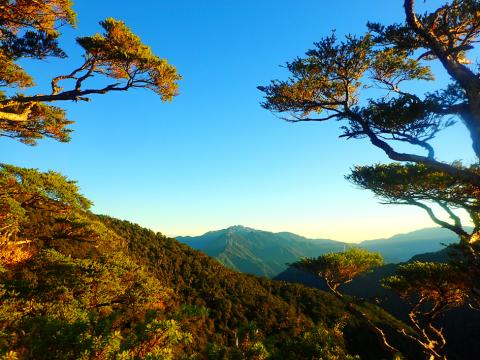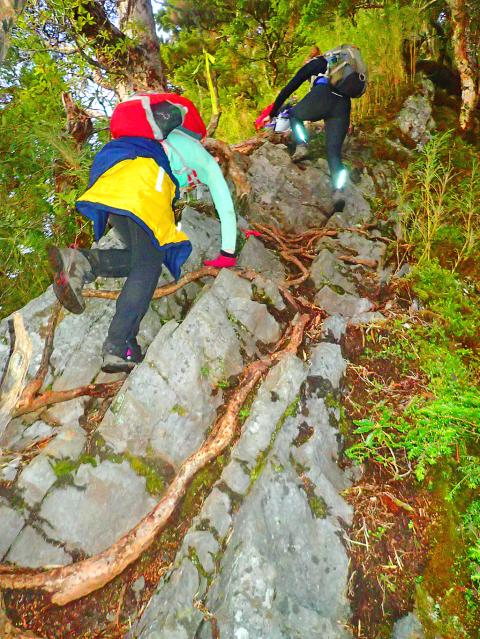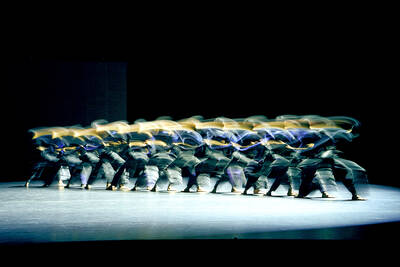Appearances can be deceptive, and that’s definitely the case with Baigu Mountain (白姑大山), the 3,341-meter-high mountain that straddles the border between Taichung and Nantou County. One of Taiwan’s “Top Hundred Peaks” (it comes in at 45 on the list) it’s a surprisingly little-known trek, considering permission to climb it is easier to get than most of its brethren (only a police permit is required), and it’s an absolutely cracking climb.
Baigu Mountain is among the tougher peaks on the list that I’ve done to date (it’s on a level with Chilai North Peak and Nanhu Mountain), but it repays all that effort with its unexpectedly stunning beauty. Photos of the mountain published on blogs and elsewhere usually show only the deceptively gentle, wooded summit dome, which appears little more challenging than a Yangmingshan peak. It’s a tough two-day hike, and one that’ll long stick in the memory, with plenty of knee-breaking ups and downs, and absolutely stunning views over the surrounding wilderness.
The trailhead lies in the middle of nowhere, at the very end of a long, winding track that climbs up from the little Aboriginal village of Hongsiang (紅香), itself reached by a long mountain road (now thankfully paved) from the villages of Wushe (霧社) to the south, or Lishan (梨山) in the north. The road is so narrow that anything bigger than an eight-seater minibus like the one we used to get up there won’t make it. Vehicles stop at the highest farmhouse on the road, guarded by a lovely black pup, sadly kept permanently chained to a post on the veranda of the building, and rather shy of strangers.

Photo: Richard Saunders
Above the farmhouse, a track winds up to a red metal sign that rather sternly announces that Baigu Mountain is “…an advanced trek, potentially dangerous in parts and only suitable for experienced hiking groups.” Baigu Mountain has a certain reputation among hiking groups, mainly because in the past it was often climbed from near Deji (德基) on highway eight, to the north, an extremely steep and strenuous route. Since the stretch of the highway on which that trailhead lies was closed following the devastating 921 Earthquake of 1999, the present trail, from the south, has become the only way to climb the mountain. Tragically, it was while climbing Baigu Mountain in 2011 that solo hiker Chang Po-wei (張博崴) became lost and fell into a gorge not far from the start of the trail. He was only found after a seven-week search, and had died only a few days before his body was found. His mother, Sharon, later went on to found the Taiwan Mountain Association, which has since been fighting to improve education, safety and access to Taiwan’s mountains, holding an annual international conference, and among much else successfully campaigning for easier access by hikers to PLBs (personal locator beacons), the import and use of which at the time of Chang’s accident were strictly controlled and extremely hard to obtain.
It’s four hours from the trailhead to the rough campsite where most people spend the first night, beside the only reliable water source on the mountain: a cluster of three of four dirty-looking brown puddles collectively called Sihyan Pond (司晏池). The water looks disgusting, but tastes tolerable and is fine to drink after boiling or filtering.
Trekkers hoping to summit and get back down the mountain on day two must get up at 3 am on the second day, as it’s a long and tough day’s hike, even with light day packs. The trail ascends steeply through bamboo and dense forest to the southeast peak of Baigu Mountain (3,035 meters), then drops steeply in the first of a series of tiring ups and downs on the way to the final summit climb. On this second day of the trek alone there’s a gain of 1,100 vertical meters, and a descent of 2,000 meters.

Photo: Richard Saunders
After a couple of sweaty hours’ climb, the trail follows the edge of cliffs, and the next section follows a very narrow ridge with sheer drops on either side, some impressive crags, and lots of fairly easy but eventually tiring rocky pitches to scramble up. It’s slow going, but here the mountain finally reveals its real character, with stunning rock formations, beautifully weathered coniferous trees hanging over vertiginous precipices, and panoramas over a huge expanse of rugged, unpopulated wilderness.
The wooded summit dome of Baigu Mountain is visible for some time before the trail climbs through a small patch of grassy meadow and begins the tough final slog to the top, up a huge and very steep boulder slope. It’s an exhausting climb — the toughest part perhaps of the whole trek, and strongly reminiscent of the climb to Yushan Front Peak, but even longer and steeper.
At the top, the mountain falls away precipitously on the far side, and following the narrow blade of the ridge, it’s less than five minutes to the trig point and a sublime, almost 360-degree view. To the north is the huge gorge of the Dajia River (大甲溪). To the west, several mountains of the Seven Heroes of Guguan (谷關七雄) can be seen, and beyond, the huge sprawl of Taichung spreads over the plains in the distance. We even fancy that we can see the sea in the slightly different shade of blue on the horizon.

Photo: Richard Saunders
After a 3am start, trekkers should reach the summit between 7am and 8am. The day is still young, but don’t hang around if you hope to get back to the trailhead before dark — the return hike (including a few short rests, which you’ll definitely need) is a further 10 hours.
Richard Saunders is a classical pianist and writer who has lived in Taiwan since 1993. He’s the founder of a local hiking group, Taipei Hikers, and is the author of six books about Taiwan, including Taiwan 101 and Taipei Escapes. Visit his Web site at www.taiwanoffthebeatentrack.com.

Most heroes are remembered for the battles they fought. Taiwan’s Black Bat Squadron is remembered for flying into Chinese airspace 838 times between 1953 and 1967, and for the 148 men whose sacrifice bought the intelligence that kept Taiwan secure. Two-thirds of the squadron died carrying out missions most people wouldn’t learn about for another 40 years. The squadron lost 15 aircraft and 148 crew members over those 14 years, making it the deadliest unit in Taiwan’s military history by casualty rate. They flew at night, often at low altitudes, straight into some of the most heavily defended airspace in Asia.

Taiwan’s democracy is at risk. Be very alarmed. This is not a drill. The current constitutional crisis progressed slowly, then suddenly. Political tensions, partisan hostility and emotions are all running high right when cool heads and calm negotiation are most needed. Oxford defines brinkmanship as: “The art or practice of pursuing a dangerous policy to the limits of safety before stopping, especially in politics.” It says the term comes from a quote from a 1956 Cold War interview with then-American Secretary of State John Foster Dulles, when he said: ‘The ability to get to the verge without getting into the war is

Beijing’s ironic, abusive tantrums aimed at Japan since Japanese Prime Minister Sanae Takaichi publicly stated that a Taiwan contingency would be an existential crisis for Japan, have revealed for all the world to see that the People’s Republic of China (PRC) lusts after Okinawa. We all owe Takaichi a debt of thanks for getting the PRC to make that public. The PRC and its netizens, taking their cue from the Chinese Communist Party (CCP), are presenting Okinawa by mirroring the claims about Taiwan. Official PRC propaganda organs began to wax lyrical about Okinawa’s “unsettled status” beginning last month. A Global

Like much in the world today, theater has experienced major disruptions over the six years since COVID-19. The pandemic, the war in Ukraine and social media have created a new normal of geopolitical and information uncertainty, and the performing arts are not immune to these effects. “Ten years ago people wanted to come to the theater to engage with important issues, but now the Internet allows them to engage with those issues powerfully and immediately,” said Faith Tan, programming director of the Esplanade in Singapore, speaking last week in Japan. “One reaction to unpredictability has been a renewed emphasis on